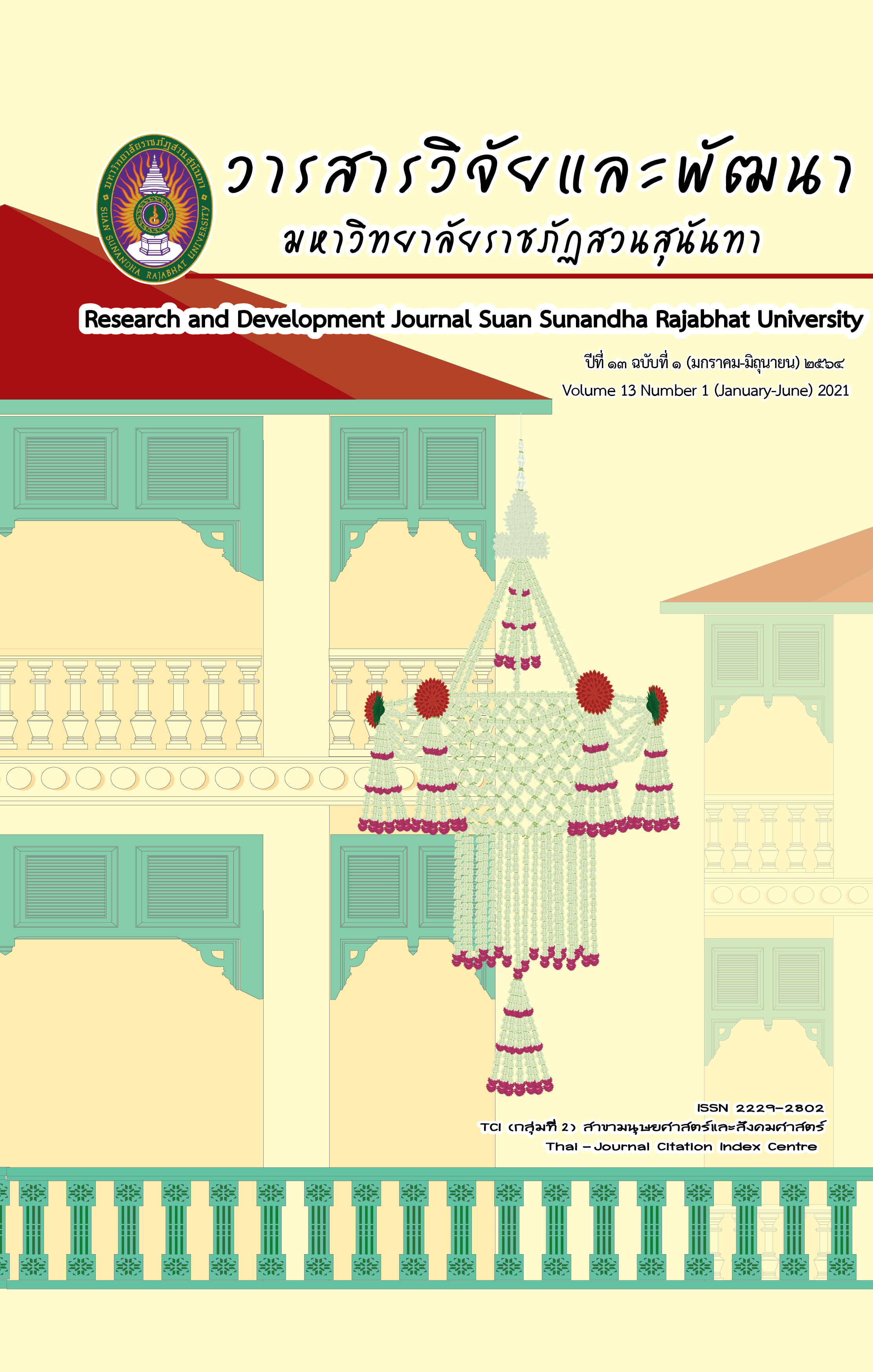การพัฒนารูปแบบการเรียนการสอนตามแนวคิด STEAM เพื่อส่งเสริมทักษะการสร้างสรรค์นวัตกรรมทางเทคโนโลยี
DOI:
https://doi.org/10.53848/irdssru.v13i1.247043คำสำคัญ:
แนวคิด STEAM, สร้างสรรค์นวัตกรรมทางเทคโนโลยี, รูปแบบการเรียนการสอนแบบ 6Ds Modelบทคัดย่อ
การพัฒนาของรูปแบบการเรียนการสอนตามแนวคิด STEAM เพื่อส่งเสริมทักษะการสร้างสรรค์นวัตกรรมทางเทคโนโลยี เป็นการประยุกต์การจัดการความรู้ การเรียนการสอนที่สอดคล้องในศตวรรษที่ 21 โดยแนวคิด STEAM และทักษะการสร้างสรรค์นวัตกรรมทางเทคโนโลยี เกิดขึ้นได้ด้วยความคิดสร้างสรรค์และมีจินตนาการ สามารถสื่อสารความคิดของตนเอง มีความสมบูรณ์ทั้งการใช้งาน ความสวยงาม และการเรียนรู้ร่วมกัน ฝึกฝนแก้ไขปัญหาและอุปสรรคที่เกิดขึ้นในสังคม ทันต่อการเปลี่ยนแปลงของเทคโนโลยี ใช้ความรู้ในศาสตร์ต่าง ๆ มีการสื่อสารแนวคิดใหม่ไปสู่ผู้อื่น สามารถสร้างและใช้ประโยชน์จากรูปแบบใหม่ ๆ ที่ทำขึ้น ซึ่งจะสามารถพัฒนาศักยภาพส่งเสริมในการจัดการเรียนรู้ เพื่อให้ผู้เรียนได้เกิดความเข้าใจและนำไปใช้ในการเรียนรู้ เพื่อนำไปสู่การพัฒนาทักษะการสร้างสรรค์นวัตกรรมทางเทคโนโลยี รูปแบบการเรียนการสอนแบบ 6Ds Model เป็นรูปแบบที่เป็นแนวคิดการจัดประสบการณ์เรียนรู้แบบบูรณาการที่เชื่อมโยงระหว่างวิทยาศาสตร์ เทคโนโลยี วิศวกรรมศาสตร์ ศิลปะ และร่วมกับแนวคิดเกี่ยวกับการสอนแบบโครงงาน แนวคิดเกี่ยวกับการเรียนรู้แบบบูรณาการ แนวคิดเกี่ยวกับกระบวนการคิดเชิงออกแบบ มีกระบวนการจัดการเรียนรู้ หลักการประกอบด้วย 6 ขั้นตอนได้แก่ 1.การระบุปัญหา (Define) 2.รวบรวมข้อมูล (Discover) 3.ออกแบบวิธีการแก้ปัญหา (Distribute) 4.พัฒนา (Develop) 5.การทดสอบและประเมินผล (Decision) และ 6.การนำเสนอผลลัพธ์ (Display) ส่วนการวัดและประเมินผลทักษะการสร้างสรรค์นวัตกรรมทางเทคโนโลยีแบ่งออกเป็น 5 ด้าน ได้แก่ 1) การระบุปัญหาที่เป็นจุดเริ่มต้นในการสร้างนวัตกรรม (Identify) 2) การสร้างแนวคิดหรือแนวทางใหม่ (Explore) 3) การทำงานร่วมกับผู้อื่นได้อย่างสร้างสรรค์ (Connect) 4) การนำแนวทางที่ได้พัฒนาไปสู่ตนเอง (Develop) และ 5) การนำแนวทางที่ได้พัฒนาไปสู่การปฏิบัติจริง (Practice)
เอกสารอ้างอิง
Ambrose, G., & Harris, P. (2009). Basics design: Design thinking. La Vergne, TN: Ingram Publisher Services.
Anthony, S. D. (2012). The little black book of innovation: How it works, how to do it. Boston, MA: Harvard Business Review Press.
Brown, T., & Katz, B. (2009). Change by design: How design thinking transforms organizations and inspires innovation. New York: Harvard Business Review Press.
Chaiwat Sutthirat. (2010). 80 Innovative learning management that focuses on learners. Bangkok: Danex Inter.
Chaiwichit Chianchana. (2017). Creating and developing model. Silpakorn Educational Research Journal, 9(1), 1-11.
Chintana Sirithanyarat. (2013). The development of science instructional model by integarting higher order thinking strategies to enhance higher order thinking skills in 21th century and scientific mind of secondary school students (Doctoral dissertation). Silpakorn University, Nakhon Prathon.
Dechakup, P., Yindeesuk, P., & Meesri, R. (2010). Teaching with thinking project: Integrated teaching and learning. Bangkok: Chulalongkorn University Press.
Dick, W., Carey, J. O., & Carey, L. (2005). The systematic design of instruction. (6th ed.). Boston: Pearson.
Eisenberg, M., & Berkowitz, B. (2017). Big 6 skills overview. Retrieved June 15, 2020, from http://big6.com/pages/about/big6-skills-overview.php.
Hathaipat Kraiwan and Pattamavadi Lehmongkol. (2017). Learning experience provision of the steam education on preschool children’s creative problem solving ability. Kasetsart Educational Review, 32(1), 123-133.
Jiraporn Rodpuang. (2016). Development of a professional learning community model to enhance the skills of learning management, systems thinking and creative innovation of student teachers (Doctoral dissertation). Srinakharinwirot University. Bangkok.
Kim, H., & Chae, D. H. (2016). The development and application of a STEAM program based on traditional Korean culture. Eurasia Journal of Mathematics, Science and Technology Education, 12(7), 1925-1936.
Kittipong Phumpuang. (2015). The development of e-leaning model by collaborative learning on social media to develop information literacy skills for undergraduate students of educational faculty (Doctoral dissertation). Silpakorn University. Nakhon Prathon.
Kruse, K., & Keil, J. (2000). Technology-based training: The art and science of design, development, and delivery. San Francisco, CA: Jossy-Bass/Pfeiffer.
Lardizabal, A. S. (1977). Principles and methods of teaching. (2nd ed.). Quezon, Philipine: Alemar-Phoenix.
Lawson, B. (1980). How designers think. London: The Architectural.
Luchs, M. G., Swan, K. S., & Griffin, A. (2016). Design thinking: New product development essentials from the PDMA. Hoboken, NJ: Wiley.
Maream Nillapun and Siriwan Vanichwatanavorachai. (2015). The development of learning innovation for basic education level with community participation on museum and local learning resourcesfor the creative learning. Veridian E-Journal, Silpakorn University, 8(1), 48-61.
Ministry of Education. (2007). The problem-based learning management. Bangkok: Agricultural Cooperative Assembly of Thailand.
Namtip Wipawin. (2009). Reading literacy, information literacy, and ICT literacy. Journal of Library and Information Science Srinakharinwirot University, 2(1), 109-123.
Office of the High School Administration. (2010). Digital literacy world-class standard school. Bangkok: Minsitry of Education.
Phayat Wutthirong. (2014). Innovation management: Resource learning organization and innovation. Bangkok: Chulalongkorn University Press.
Plattner, H. (2018). Mini guide: An introduction to design thinking + bootcamp bootleg (Creative process guide). Spain: Institue Design of Standford.
Puchong Rojsangrat. (2016). Development of an instructional model using design thinking to create thai products identity for undergraduate students (Doctoral dissertation). Chulalongkorn University, Bangkok.
Royal Thai Embassy, Washington D.C. (2016). Thailand 4.0 thriving in the 21st century through security, prosperity & sustainability. Retrieved June 15, 2020, from https://thaiembdc.org/2016/11/21/thailand-4-0-thriving-in-the-21st-century-through-security-prosperity-sustainablility/.
Sooraksa, P., Sakorntanant, S., Jansri, A., & Klomkarn, K. (2016, June). Tree robot: An innovation for STEAM education. In 2016 IEEE International Conference on Real-time Computing and Robotics (RCAR) (pp. 338-341). Angkor Wat, Cambodia: IEEE.
Subuun Leamvijarn, Prasert Janyasupab, Surachai Kungwon, and Somkiat Chaipiboon. (2010). Technological innovation efficiency analysisof gems and jewelry SMEs in Thailand. Economics and Public Policy Journal, 9(17), 35-52.
The Institute for the Promotion of Teaching Science and Technology. (2014). STEM education. Bangkok: Author.
Tipparat Sittiwong. (2016). Instructional system design. Bangkok: V.print.
Tisana Khemmani. (2012). Science of teaching: Knowledge of efficient learning process management. (15th ed.). Bangkok: Chulalongkorn University Press.
Wichai Wongyai and Marut Patphol. (2014). Coaching paradigm to enhance creativity and innovation skills. Bangkok: Charansanitwong Press.
Wisud Po-Ngern. (2017). STEAM, arts for STEM education: improvement in perception, capacity and inspiration for children. Journal of Education Studies, 45(1), 320-334.
Yakman, G. (2008, February). STEAM education: An overview of creating a model of integrative education. In Pupils' Attitudes Towards Technology (PATT-19) Conference: Research on Technology, Innovation, Design & Engineering Teaching. Salt Lake City, Utah, USA.
ดาวน์โหลด
เผยแพร่แล้ว
รูปแบบการอ้างอิง
ฉบับ
ประเภทบทความ
สัญญาอนุญาต
บทความที่ได้รับการตีพิมพ์เป็นลิขสิทธิ์ของ สถาบันวิจัยและพัฒนา มหาวิทยาลัยราชภัฎสวนสุนันทา
ข้อความที่ปรากฏในบทความแต่ละเรื่องในวารสารวิชาการเล่มนี้เป็นความคิดเห็นส่วนตัวของผู้เขียนแต่ละท่านไม่เกี่ยวข้องกับมหาวิทยาลัยราชภัฎสวนสุนันทา และคณาจารย์ท่านอื่นๆในมหาวิทยาลัยฯ แต่อย่างใด ความรับผิดชอบองค์ประกอบทั้งหมดของบทความแต่ละเรื่องเป็นของผู้เขียนแต่ละท่าน หากมีความผิดพลาดใดๆ ผู้เขียนแต่ละท่านจะรับผิดชอบบทความของตนเองแต่ผู้เดียว





